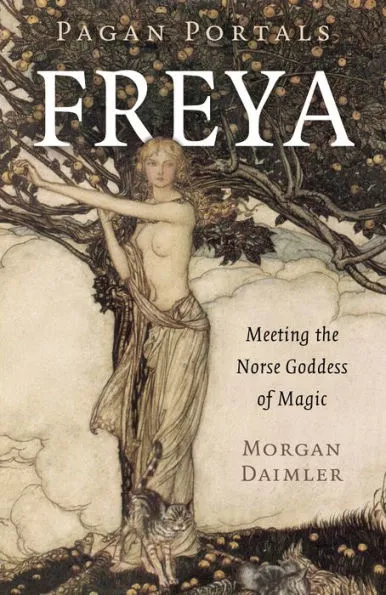Morgan Daimler is a prolific author, especially about fairy lore and goddesses. I was eager to read her new short Pagan Portals book about Freya because, as I suspected and as Daimler concludes, Freya is “more than just a beautiful face or a bringer of love, more than just the ‘Norse Venus’.” She represents both “the beautiful and the terrifying.”
We read in Daimler’s introduction that the name “Freya” derives from an Old Norse word meaning lady or woman, a general term or title. A modern word related to Freya’s name is the German “frau,” meaning woman or wife. That the name Freya is so generic shows her wider importance in German and Norse cultures but it makes research about her harder. Daimler acknowledges that this book is more of a starting point than an exhaustive treatment.
Freya’s familial relationships are complex. She has been integral to various northern European mythologies across many centuries. Some aspects of the mythologies are perpetually debated, including whether Freya and Frigga are one in the same or distinct deities.
Freya is a goddess associated with love, sex, fertility, remembrance of the battle dead, and with the shamanic-like practices of seidhr. The sixth day of the week, Friday, is named after Freya according to some Icelandic sources. Amber has long been a symbol of Freya, used for protection and healing. Amber has been used by humans for at least 10,000 years as evidenced in archeological discoveries.
Daimler delves into how Freya figures into seidhr. As practiced today, Daimler writes, seidhr is a “reconstructed practice and how it is practiced varies greatly from person to person or group to group.” Any type of seidhr work, for Daimler, involves some level of trance work.
Connecting with Freya, Daimler writes, has her wanting to raise a subject mentioned often in the Heathen community, of which she’s a participant: “unverified personal gnosis.” She shortens this to “personal gnosis.” It is spiritual knowledge “gained through direct spiritual experience, dreams, visions, or similar personal sources and which can’t be verified in older material.” If it’s from verified lore, it’s not personal gnosis. If people find they’ve had similar experiences without knowing each other ahead of time, that’s shared personal gnosis or group gnosis. Much of what’s going on among people who work with Freya, Daimler says, is in the category of group gnosis, i.e. not necessarily verified through historical source material.
For making connections with Freya as an individual practitioner or with a group, Daimler’s got lists of useful tools, such as statues, shrines and correspondences for offerings. Ultimately, Daimler says, “all you really need is a willingness to be open to her.
In connecting to Freya in our current context, Daimler offers what she calls a “caveat to readers,” and it’s this: One “problematic aspect of modern Heathenry, and by extension an issue that will impact anyone seeking to understand or connect to Norse gods,” is white supremacy. Since the beginning of the revival of Heathen spirituality, the ugly and dangerous shadow of Nazism and neo-Nazism has been a factor to be cognizant of, and to steer clear from. I’m glad Daimler made that explicit point even in this short treatment of the goddess Freya.
Recommended.
~review by: Sara R. Diamond
Author: Morgan Daimler
Moon Books, 2023
78 pages, $12.95

